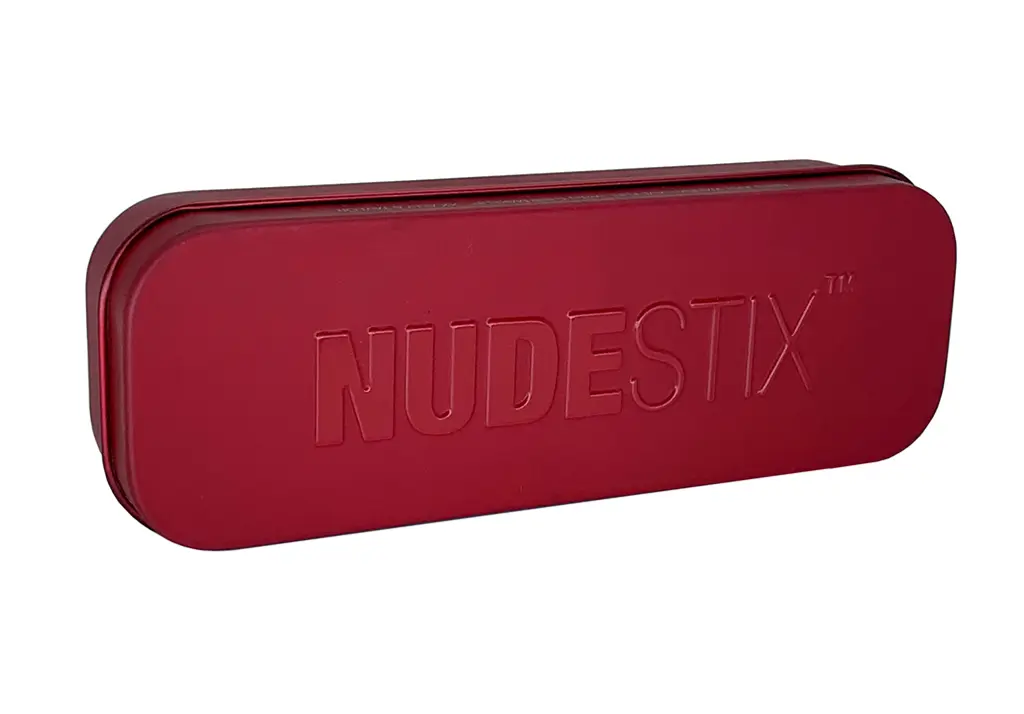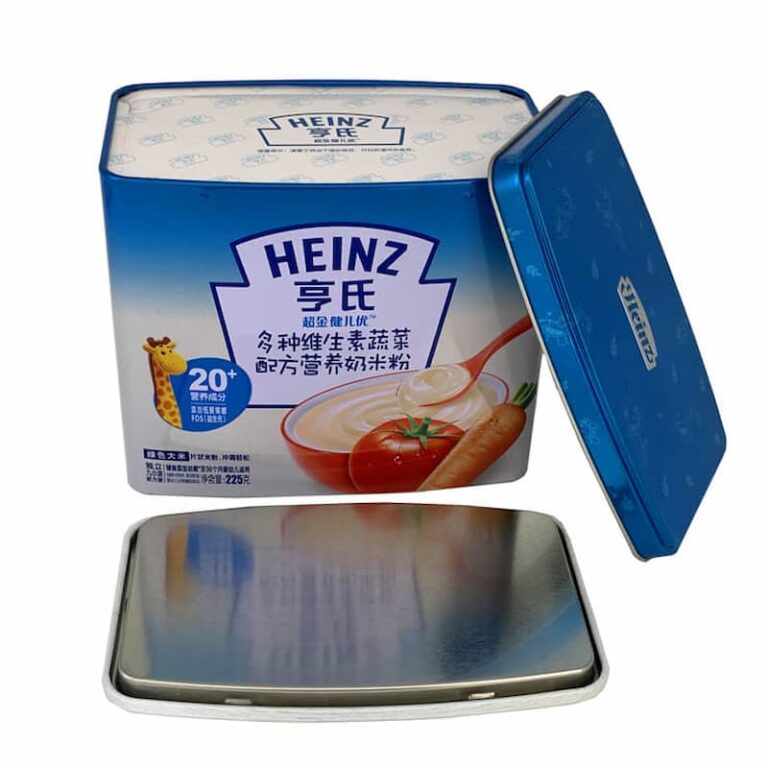Embossing is a great way to make your artwork, such as your logo, stand out on the tin packaging. This technique can be particularly effective for creating a premium, high-end look.
Debossing, on the other hand, can be used to add subtle texture and depth to your packaging, creating a more understated and sophisticated look.
When choosing between embossing and debossing for your tin packaging, it’s important to consider the overall design and aesthetic you want to achieve, as well as the specific materials and techniques that will work best for your product. With careful planning and experimentation, you can create packaging that truly stands out and resonates with your target audience.
The Process of Embossing Onto Tin Packaging

Embossing is a popular technique used in the design of packaging and other products, and it involves creating a raised design on the surface of the material. The process starts with the creation of a metal mold, known as an embossing mold, which has the raised graphic on it that you want to emboss onto the final product. This embossed mold is then pressed into the product, raising the profile of the design and adding a three-dimensional effect.
Embossing is different from raised ink printing, also known as thermography, which involves using a special powder that binds to the material when it is formed into shape. Embossing, on the other hand, involves actually changing the shape of the material by pressing it with a metal mold.
While embossing may have a higher setup cost compared to some other techniques, the quality and impact it can have on a finished product are undeniable. It adds a touch of elegance and exquisite style to packaging and other products, making it a popular choice for those looking to create a premium and high-end look. Whether you are working on a small-scale or large-scale project, the durable metal molds used in the embossing process can accommodate a wide range of needs.
The Process of Debossing Onto Tin Packaging

Debossing is a technique similar to embossing, but rather than creating a raised design on the surface of the material, it involves pressing the design down into the material to create an indented or sunken appearance. In the debossing process, a metal mold with the desired design is pressed down onto the material from the top, indenting the design into the product.
Debossing is not as commonly used as embossing, but it can be a great way to add subtle texture and depth to your packaging or other products. It can create a more understated, sophisticated look compared to the bold, three-dimensional effect of embossing. Debossing is often used in combination with embossing, as the two techniques can work together to create a cohesive and visually interesting design.
Select The Area of Your Design To Be Embossed

Many companies want to have their entire logo embossed on a tin box surface. This is possible, however, it is often more effective to emboss only a portion of the logo. This can help to create a more balanced and visually interesting design, rather than overwhelming the viewer with too much-raised text or graphics.
For example, you could consider embossing only the initials, logotype, or a pattern from your logo, rather than the entire design. Alternatively, you could emboss some of the text from your logos, such as the company name or tagline. By carefully selecting which elements of your logo to emboss, you can create a more cohesive and impactful design.
Enhanced Multi-Finishing Options
Choosing to emboss vs deboss is a matter of preference and will depend on the specific goals and aesthetics you have in mind for your tin packaging. Both techniques can add visual interest and depth to your design, and the right choice for you will depend on the tinplate materials you are using and the overall look you want to achieve.
However, there are also ways to customize and further refine the appearance of your embossed or debossed design. For example, you can use different finishing options to highlight and enhance the style of your tin packaging. Customizing the tin mold used in the embossing and debossing process can add an extra level of depth and detail to your packaging design, giving it a more “sculpted” appearance. By creating multiple layers of raised or recessed design, you can create a more dynamic and visually interesting finish for your product.
In addition to customizing the embossing or debossing process, there are also other accents, varnishes, and printing finishes that can add a touch of sophistication to your tin packaging design. Options such as metallic luster, aqueous coating, and matte or gloss varnishes can all help to create a unique and visually appealing finish for your product. By exploring different finishing options, you can take your packaging design to the next level and create a truly standout look.
Why Debossing Is Often Combined With Embossing?

Debossing is often used in combination with embossing because the two techniques can work together to create a cohesive and visually interesting design. Embossing involves creating a raised design on the surface of the material, while debossing involves pressing a design down into the material to create an indented or sunken appearance.
By combining the two techniques, you can create a design with multiple layers of raised and recessed elements, adding depth and dimensionality to the packaging or other product. This can create a more dynamic and visually appealing finish, and it can help to create a cohesive and cohesive look across the entire product.
In addition to the visual impact, using embossing and debossing together can also help to enhance the tactile experience of interacting with the product. The raised and recessed elements can add texture and interest to the surface, making it more enjoyable to touch and handle.
Embossing vs Debossing: Which Is Best For Your Tin Packaging?
At Tinshine, we understand that the difference between embossing and debossing can be a complex task, especially if you are new to the world of tin packaging design. That’s why we offer a range of detailed packaging services to help you navigate the process and bring your vision to life.
Our tin factory has the knowledge, experience, and expertise to guide you through every step of the packaging design and production process, from concept to completion. We can help you choose the right techniques, tinplate materials, and finishes to create a packaging design that truly stands out and resonates with your target audience.
If you are looking for assistance with your tin packaging project, we encourage you to request a free quote today. We will be happy to provide more information about our services and help you see why so many companies, large and small, rely on us to turn their brand packaging vision into reality. So, don’t hesitate to contact us for all your tin packaging needs.
FAQ:
Both methods use the machine to press your design into the product surface you’re customizing.
Embossing creates a design that pops out from the tin’s surface, making it raised and noticeable. On the other hand, debossing creates a design that sinks into the tin, giving it a carved or pressed-in appearance. Both techniques can add visual interest and depth to your packaging.
Embossing is a decorative technique that involves creating raised designs on various materials, like paper, tin boxes, metal, leather, glass, or plastic. This is achieved by using the metal emboss mold to press the design parts into the material’s surface. The result is a three-dimensional pattern that stands out from the background, adding a tactile and visually appealing element.
Branding Impact: If you want your logo or design to stand out prominently on the tin box, embossing can create a visually striking and raised effect that draws attention.
Luxurious Aesthetics: Embossing adds a touch of luxury and elegance to the tin box, making it an excellent choice for high-end or premium products.
Elegance: Debossing creates an indented design that imparts a subtle and refined touch to the tin box. If you want a more understated but classy appearance, debossing is a great choice.
Personalization: For customized text or patterns that seamlessly blend with the tin’s surface, debossing offers a fine and permanent imprint.
Tactile Engagement: Debossing provides a tactile experience for those interacting with the tin box, adding an extra dimension to its appeal.






